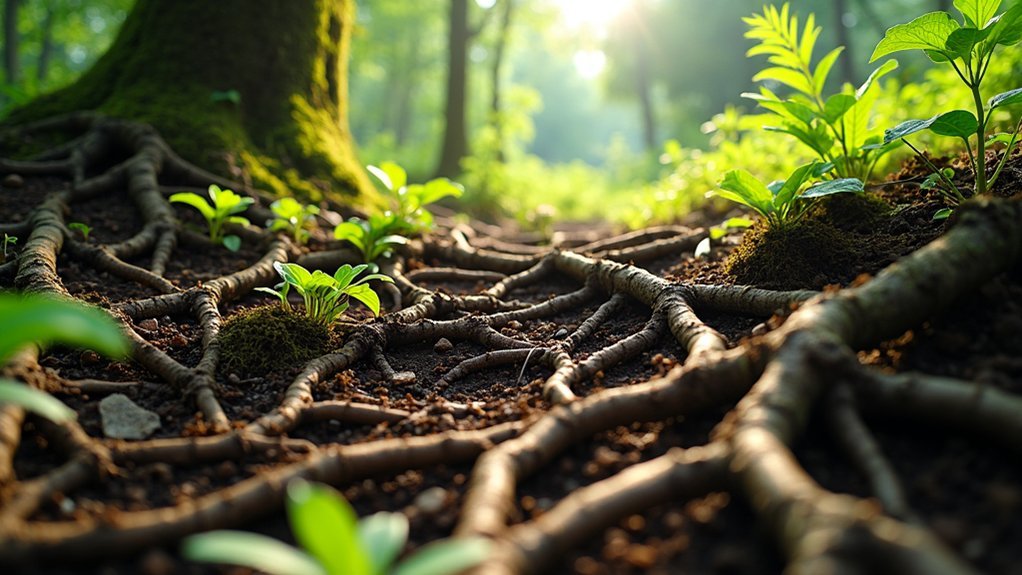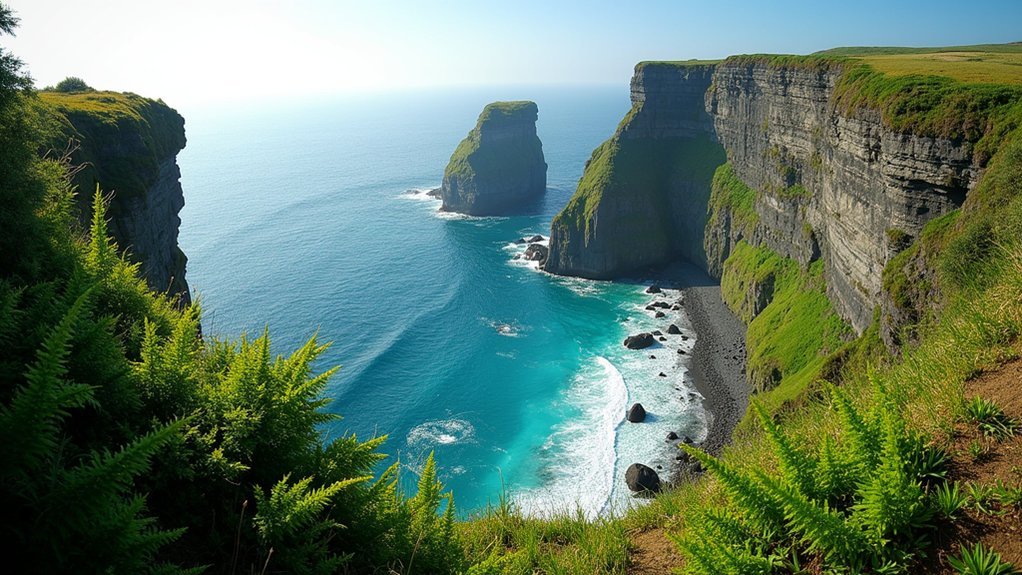Natural barriers effectively combat landscape erosion through strategic planting. Deep-rooted trees and shrubs anchor soil on slopes, while native grasses create dense mats that slow rainfall runoff. Living fence rows, riparian buffers, and bioswales all prevent soil displacement using vegetation’s extensive root systems. You’ll find these solutions require less maintenance than conventional options while enhancing biodiversity. Explore these natural approaches to discover how your property’s unique erosion challenges can become opportunities for sustainable landscaping.
Root Systems: Nature’s Underground Anchors

While often overlooked, root systems serve as nature’s most effective underground defense against landscape erosion. When you plant trees and shrubs on your property, their roots penetrate deep into the soil, creating a natural anchoring system that holds earth firmly in place—especially critical on slopes and hillsides.
Dense networks of roots from grasses and ground covers can retain up to 90% of soil during heavy downpours, preventing soil from washing away. These underground structures work double-duty by improving water infiltration while stabilizing the terrain.
Native plants offer superior erosion control with their well-adapted root systems. They’ll require less maintenance while effectively binding soil particles together.
Strategic Planting for Slope Stabilization
When tackling erosion-prone slopes, strategic planting becomes your most powerful tool against soil loss. Deep-rooted native shrubs and trees create natural anchors that secure unstable terrain and prevent soil erosion during heavy rainfall.
You’ll achieve better results by creating layers—taller vegetation at the back and shorter plants in front—which not only stabilizes the slope but creates an aesthetically pleasing landscape. Ground covers like ivy or creeping thyme form dense mats that shield soil from rain impact and reduce displacement.
For maximum effectiveness, incorporate a variety of species. This biodiversity enhances soil health while perennial plants and grasses absorb excess water, minimizing runoff.
Their diverse root structures complement each other, fostering robust plant growth and creating a natural defense system that strengthens with time.
Native Grasses as Erosion Control Barriers

Native grasses serve as nature’s frontline defense against landscape erosion, complementing the strategic plantings previously discussed.
Their extensive root systems effectively stabilize the soil by binding it together, creating natural barriers on vulnerable slopes.
You’ll find this erosion control method particularly sustainable because native grasses are already adapted to local conditions, requiring less water and maintenance than non-native alternatives.
When established, they form dense mats that intercept rainfall and slow water runoff, preventing soil displacement during heavy storms.
Living Fence Rows: Multi-Purpose Erosion Prevention
Beyond traditional landscape solutions, living fence rows offer a multi-purpose approach to erosion prevention that merges aesthetics with functionality.
You’ll find these natural barriers particularly effective as their dense root systems stabilize soil while creating valuable wildlife habitats that enhance local ecosystems.
When you install living fence rows on your property, you’ll benefit from:
- Reduced maintenance costs compared to conventional fencing, as native plants typically require less care
- Natural rainfall interception that allows water to drip gently onto soil, preventing destructive runoff
- Additional protection as windbreaks that shield your landscape from damaging high winds
These vegetative barriers prevent erosion more effectively than artificial alternatives while supporting biodiversity—making them an environmentally responsible choice for sustainable landscape management.
Riparian Buffers for Waterway Protection

Creating a protective shield along your waterways, riparian buffers serve as essential erosion control systems that safeguard both water quality and landscape integrity. These native vegetation zones can reduce sediment delivery by up to 90%, effectively preventing soil loss during heavy rainfall events.
| Buffer Type | Erosion Control Benefit | Vegetation Growth Pattern |
|---|---|---|
| Forest Buffer | High bank stabilization | Multi-layered canopy |
| Shrub Buffer | Moderate soil retention | Dense root networks |
| Grass Filter Strip | Excellent sediment capture | Rapid establishment |
| Mixed Buffer | Extensive protection | Diverse succession |
| Wetland Buffer | Superior flood mitigation | Hydrophilic adaptation |
You’ll find these buffers not only control erosion but also create wildlife corridors and enhance biodiversity. Their deep root systems anchor soil while slowing runoff, giving your landscape natural resilience against flooding and pollution.
Stone and Rock Arrangements as Natural Barriers
While riparian buffers excel at waterway protection, the strategic use of stone and rock arrangements offers another powerful approach to combat landscape erosion. You’ll find these natural barriers effectively break water flow forces, preventing soil erosion on vulnerable slopes.
Stone and rock placements create natural defensive barriers that disperse water energy and shield vulnerable landscapes from erosion damage.
When you incorporate rocks into your landscape, you’re creating both functional and aesthetic solutions:
- Large boulders strategically placed can form terraces that slow water movement and improve soil absorption.
- Riprap installations redirect destructive water flow while maintaining landscape stability.
- Rock barriers combined with strategic plantings create a dual system where root networks further strengthen soil structure.
The effectiveness of your stone arrangement depends on thoughtful design—consider size, shape, and placement to maximize erosion control while enhancing your property’s natural beauty.
Fallen Tree Placement for Erosion Control

When natural processes provide fallen trees on your property, you’ve been given a valuable erosion-control resource that shouldn’t go to waste. Position these fallen trees strategically across slopes to divert water flow and slow runoff, allowing sediment to settle rather than wash away.
The extensive root systems create natural barriers that prevent soil from being carried off during heavy rainfall. For maximum effectiveness, place logs perpendicular to water flow, creating a zigzag pattern down steeper terrain.
This approach offers multiple benefits beyond erosion control. You’ll create wildlife habitats, enhance biodiversity, and save money by using materials already available on your property.
Unlike manufactured options, fallen trees integrate naturally into your landscape while performing the essential job of soil stabilization.
Wetland Plants as Natural Water Filters
You’ll find wetland plants like cattails and bulrushes offer dual benefits as they filter pollutants from runoff while their extensive root systems stabilize soil and prevent erosion.
When selecting ideal species for your landscape, prioritize native varieties that can reduce nutrient loading in waterways by up to 80% and thrive in your local conditions.
These natural filters not only improve water quality but also slow water flow, reducing the velocity of runoff that contributes to landscape erosion.
Wetland Plant Benefits
Three remarkable qualities make wetland plants exceptional natural water filters in the fight against landscape erosion.
When you incorporate these powerhouses into your landscape design, you’ll gain multiple environmental advantages.
- Pollution reduction – Cattails and bulrushes trap up to 90% of sediments and absorb harmful pollutants, greatly improving water quality in surrounding ecosystems.
- Nutrient management – These plants efficiently reduce nitrogen and phosphorus runoff, preventing harmful algal blooms that can devastate aquatic environments.
- Soil stabilization – The extensive root systems of wetland plants protect the soil by anchoring it firmly in place, preventing erosion and maintaining wetland integrity.
You’ll not only create effective natural barriers against erosion but also foster biodiversity and ecosystem resilience when you incorporate these versatile wetland plants into your landscape strategy.
Optimal Species Selection
Selecting the right wetland plants for your erosion control strategy requires careful consideration of your specific site conditions and erosion challenges.
Cattails and bulrushes are excellent choices, removing up to 90% of pollutants while stabilizing soil with their extensive root systems.
For areas with heavy metal contamination or nutrient runoff, incorporate water lilies and sedges. These plants excel at absorbing these contaminants, preventing downstream eutrophication while improving overall water quality.
Create a diverse plant community by mixing native species that complement each other’s filtering abilities. Dense vegetation will slow water flow, allowing sediment to settle rather than wash away.
This natural barrier approach not only protects your soil from erosion but also creates wildlife habitat and enhances local biodiversity, making your erosion solution more resilient and ecologically valuable.
Permeable Natural Hedgerows for Water Management

While traditional erosion control often relies on hardscaping solutions, permeable natural hedgerows offer a sustainable alternative that works with the landscape’s natural processes.
These living barriers effectively reduce soil erosion on slopes by slowing water runoff and allowing better infiltration. The dense root systems hold the soil in place, creating a natural defense against the forces of water and wind.
You’ll benefit from these permeable natural hedgerows in several ways:
- They filter sediments and pollutants from stormwater, improving water quality across your landscape.
- Native species require less maintenance while supporting local biodiversity.
- When strategically placed, they serve as windbreaks that protect vulnerable areas while enhancing your property’s aesthetic appeal.
Bioswales and Rain Gardens for Landscape Drainage
Beyond hedgerows, bioswales and rain gardens represent nature’s drainage champions in the fight against landscape erosion.
These strategic depressions work tirelessly to capture, slow, and filter stormwater runoff from your property.
Bioswales utilize carefully selected native vegetation and engineered soil compositions to reduce the amount of surface water that would otherwise cause erosion.
You’ll find they can retain up to 90% of rainfall while creating natural filtration systems.
Rain gardens offer similar benefits on a smaller scale, perfect for residential settings.
They’re shallow planted areas that absorb water from driveways, roofs, and other impervious surfaces.
Both solutions strengthen soil with extensive root systems while providing wildlife habitat.
You’re not just preventing erosion—you’re creating functional landscape features that enhance your property’s biodiversity and visual appeal.
Layered Vegetation Strategies for Comprehensive Protection
Nature’s most effective defense systems come in layers, and your landscape should too. Layered vegetation strategies keep soil in place by utilizing plants with different root depths to create a living network that anchors your landscape.
When you combine deep-rooted trees with mid-level shrubs and ground covers, you’ll create a resilient system that withstands erosion, especially on steep slopes.
- Incorporate native plants that require less maintenance while providing superior soil stabilization through their adapted root systems.
- Structure your plantings vertically—trees, shrubs, and ground covers—to intercept rainfall at multiple levels, reducing its erosive impact.
- Focus on steep slopes first, where layered plantings can prevent dangerous soil movement while creating visually appealing, functioning ecosystems.
This multi-tiered approach not only prevents erosion but enhances biodiversity and landscape beauty.
Frequently Asked Questions
What Natural Barriers Protect Soil From Erosion?
To protect soil from erosion, you’ll benefit from natural vegetation’s root systems, ground cover plants, riparian buffers along waterways, organic mulch coverings, and strategically placed erosion control wattles on slopes.
What Are the Natural Solutions to Erosion?
You can prevent erosion naturally by planting ground cover with strong root systems, using native plants, applying mulch, adding shrubs and trees, creating water diversions, and installing erosion control blankets.
What Ways Does Nature Use to Prevent Erosion?
Nature prevents erosion through vegetation’s root systems, tree canopies that slow rainfall, wetlands that absorb excess water, natural rock barriers that redirect flow, and organic matter that improves soil structure and retention.
What Is the Best Natural Defense Against Erosion?
Vegetation is your best natural defense against erosion. You’ll find that plant roots hold soil in place, while leaves reduce raindrop impact. It’s nature’s way of protecting land from water and wind damage.
In Summary
By embracing nature’s own solutions, you’ll create resilient landscapes that withstand erosion’s constant threat. These living barriers don’t just stop soil movement—they enhance biodiversity, filter pollutants, and create beautiful, sustainable environments. Whether you’re managing a small garden or large property, you’re working with rather than against natural processes. It’s a practical approach that pays dividends for both your land and the ecosystem around you.





Leave a Reply